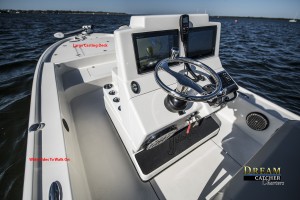What Is A Bay Boat?
What Is A Bay Boat?
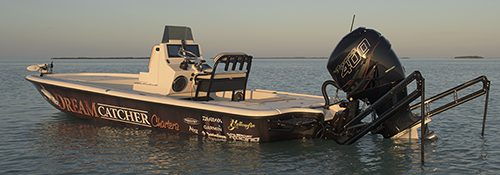
In the marine industry like anywhere, terms are chosen to position a said item in the market. Accurate or not these terms often become the next generalization of a product. Over the course of time these terms, either due to the popularity among its fans or market positioning becomes a bit more broad and starts to encompass the grey areas for a certain “key term”. Bay boat has become one of those terms. The point of this article is to put a harness on the term Bay Boat and define them for what they are for fishing, or should be. Explain some of the things we look for in a good bay boat and maybe help the reader chose a boat for themselves.
Bay boats came into being when everyone realized that there was a gap between flats fishing boats that were designed to fish the shallows and center consoles that had the reach and the build to moderately brave the seas and get boat owners out to locations in open water, otherwise known as “open fishermen” or “center consoles”. The flats boats couldn’t (shouldn’t) go offshore and the open fishermen were too deep with their wave cutting V bottoms to venture to far up into the shallows. Among other limitations each one had, neither were good at the others realm. Although many manufacturers tried to do it, there was never a good all round solution without defining a whole new category of boat.
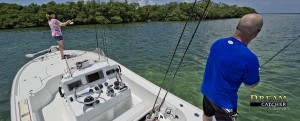
So, With a little innovation and borrowing from both sides of the industry the bay boats started to take shape to fill the void in the market. I remember back in 2005 having a discussion with some engineers at Mercury Marine about the insurgence of this bay style of boat they were seeing popping up from a few different manufacturers at the time and they asked me if I thought it was a fad. As a die hard flats fishing boat captain who owned a couple of bay boats I reluctantly said Bay boats will be the new future for inshore fishing and a very large part of the market for boating in general. I felt as strongly then as its obvious now where just about every fishing boat manufacturer out there has a Bay Boat model or two or three. At the time I had the ActionCraft 2310 Coastal bay and a 2110 ActionCraft Coastal Bay and both of these boats were running the same trips my flats boats were offering and doing it much more comfortably with our clients being much happier.
What Makes A Bay Boat, A Bay Boat?
When a boat buyer is in the market considering a bay boat they are looking for a boat that can fish the shallows using a trolling motor and get out to some of the close stuff offshore on the nicer days, so versatility is the key. Some physical features they might be looking for might be length and single engine. In my opinion the general ingredients of a bay boat are simple; 21 – 24 ft long, shallow draft, short gunwales, center console and casting decks. Sticking with these simple ingredients will keep us on the focus of what makes a great bay boat that actually does the job well.
The length
of the bay boat is very important. The use of this style of boat is directed toward fishing the flats, tight channels in and among the shoreline and here in south Florida mangrove channels. being able to effectively swing the boat around maneuver in these tight areas and float in the shallows lends itself to being no more than 24 feet in length. With 24 feet an effective and stable fishing platform will result from creating casting decks areas around the cockpit. Plenty of room for up to 4 anglers to fish and not kill each other in casting. There are bay boats now in production that are longer than 24ft. Boasting more room in the cockpit and a better ride. These longer boats did not increase their beam by much if any when they added the extra, they also increased the dead rise of the bottom and therefore increased the draft and made it more difficult in tight spots and not very shallow ultimately being more effective offshore in open water and NOT considered a real bay boat in my opinion. A last consideration for length is storage. With marina storage at a premium and our garages and yard areas getting smaller the size of the boat matters. It seems 24 ft is the cut point for many reasons to be the max size for a bay boat.
Draft
By definition draft is how shallow a boat will float and still be functional for fishing, in this case, while being propelled by trolling motor. When choosing a great bay boat draft should be a major consideration and might be one of the more determining factors. Not to replace a technical poling flats fishing skiff but to offer the accommodations of a larger boat that gets shallow and be operated and fished by the same person. How shallow should it go? Trolling motors need at least 10″ of water to operate effectively without making a bunch of noise slurping their way across the shallows. So, we have learned that 15″ or less is the perfect potential draft for what we consider a real bay boat. This should be accomplished with a bait well full of water and three guys on board ready to fish. I always want to iterate
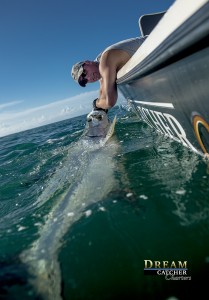
Short Gunwales (the boat sides)
The height of the bay boat is a very important feature for me. Because I use my bay boat so much on the flats and in the shallows the shorter profile suits me best for a few reasons. First, shorter shaft needed for my trolling motor to reach the water. When shopping for a real bay boat that you will be using in the shallows, trolling motor shaft length is a consideration. You don’t want the bow sticking up so high you need a 70″ shaft to fully submerge your trolling motor. Another reason is windage, the amount of effect the wind has on the boat. The sail area affects me on how well I can fish in the shallows. The bay boats I use do not have t-tops and are low sided in comparison to the rest of the industry. Other considerations are landing big fish such as tarpon. We don’t take the larger tarpon out of the water any more so with the lower hull sides its easier to get a photo of my anglers hanging on to the lip of the tarpon they just caught for the memory without lifting him from the water. One of the many reasons I chose the Yellowfin 24 as my boat of choice is for the low profile. an argument for low hull sides might be sea conditions. I might agree if I were using this boat like I would a larger center console made for high seas.
Casting decks
are very important on a bay boat. An upper deck area that is easy to stand on with ample room to fish from without losing your balance. Most bay boats offer enough forward casting deck for three full grown men to stand in the front. Furthermore there is usually a deck in the back of the boat behind the console that offers an area to cast from as well. Personal taste will dictate one design from another. I prefer as much casting deck as possible in my bay boats leaving me enough room to walk around my console and leaning post without getting jammed up. Another great feature that I have in my Yellowfin 24 is the walk area I have along the side from the back casting area to the front without having to step down on my cockpit deck. A feature not found in many bay boats but an important one for me and the way I fish with my anglers.
Why center console? Center consoles have been around since the early 70s. One of the first ones that I recall were the Aquasport, anglers and Mako, I would consider them the pioneers of center console fishing boats. Center console basically means a central area (box) where the control of the boat and windscreen are located. Facilitated to where the user can walk around both sides to move forward in the boat and stand behind to operate the boat. Center consoles have made their way into some behemoth sized boats these days up to 60 ft. in all sorts of form and size. Bay boats tend to be center console in style. There are a couple dozen ways the center console can be set up for a bay boat and again each is a preference to the buyer.
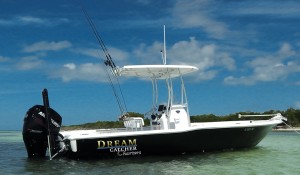
Value in a bay boat
Is a question I get asked many times through the course of a model year. I try and keep up with trends and builds of the different manufacturers even making sure I have owned one or the other style of boats as well as my Yellowfin bay boats. There seems to be no limit to what a buyer can spend on a bay boat these days. That was evident at this years 2016 Miami International Boat Show where prices of these boats were at a premium. By definition I put manufacturers in two categories. Factory and Custom builders. A factory builder is typically the more affordable builder. Factory builds many boats in concession on a floor where the actual build, wiring, pipe work, components are all a assymbled and designed to put out a number of boats quickly based on an allocation to their dealers, then the dealers finish off the customization installing electronics, lighting and some gadgets. Ordering a factory boat to spec is not impossible but typically folks see what they like on the floor at the dealership. Its a see it – buy it feeling. A custom builder is a lower volume but typically higher value builder with a much longer wait. This is usually a factory direct experience where the buyer sits with the builder and choses the components from a list and custom builds their boat to specification. Then the builder builds each boat individually. Sometimes as long as 8 – 10 months is the norm for a custom built boat.
Which is better?
I have owned several of both. I have found that all of the factory built boats I have owned have been lacking in components, attention to detail and wiring for the saltwater world, in my opinion you get what you pay for or want to wait for. I have also found the factory built boats to be a couple years behind in the innovations of this market. The physical build of the hulls and deck of my factory boats have been very good lately and the pricing is about 80% of a custom built factory direct boat. The only custom built factory direct bay boats I have owned are the Yellowfin 24 by Yellowfin Yachts and the ActionCraft Coastal Bay series before that. I will reflect on the Yellowfins and say that never once have I received a boat from them that I could not put directly in service right from the day of delivery. I will go on record say I have never been disappointed in any of the 9 Yellowfin built boats I have owned. Resale is a feature that all of us would like to retain when buying any boat. I have found that my custom boats hold the best resale value. Reasons being quality or the lead time to have a new one built.
The last part of the value is the service. One of the things to consider when buying a bay boat is who is going to do the warrantee work on it. Your local boat dealers may have a brand and a good name to rely on for this convenience many custom builders don’t have dealers all over to help you out. In fact you may have to bring the boat back to the factory to fix some stuff. All things to look into when weighing your purchase.
The use of a bay boat will vary from one person to another. fitting a niche in their own personal world of boating. For me a bay boat should be the super boat of inshore and near shore fishing. The all in one boat of all boats that can do just about everything its larger center console brother can do on a nice day or almost as shallow as its little flats fishing brother can do any day of the week. I have my personal bay boats built on right on the edge of state of the art. I want my boat to be light, rigged well, very fast and float like a ballerina on the flats where I fish. I only go offshore to the reefs and wrecks on the nicer days in my bay boats and on those days there are only fuel limits to the distances I will run on my 250 mile range. Many folks tell me they want a boat that will run in 4-6 ft seas and still float in 12 inches of water. That boat does not exist – yet.
Having been in this industry for over 30 years I have seen the changes come and some of them go. My passion about boating and fishing is what I love to share with folks to help them make the most out of their boating dollar and the very short time most of us get to be on the water. Please feel free to contact me by email and ask questions about bay boats, motors and things to look for on your next purchase. If you are in Key West and want a ride on any of my 8 bay boats please contact me and I will be delighted to get you on the water with one – Free of charge for a quick spin on one of our Mercury Powered boats.

